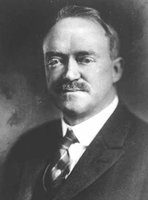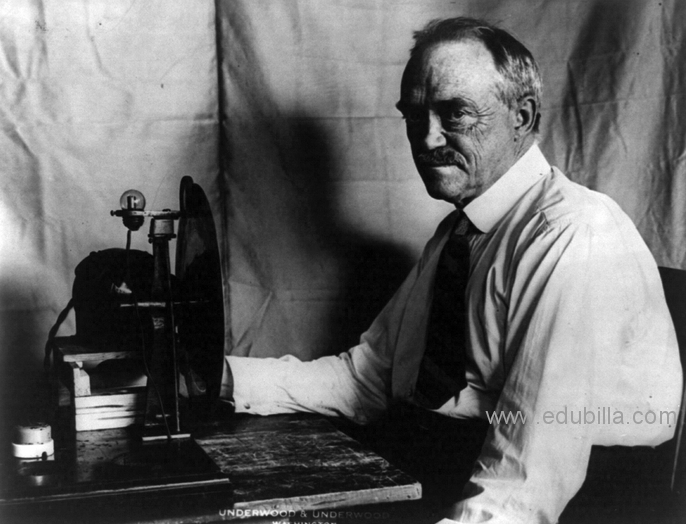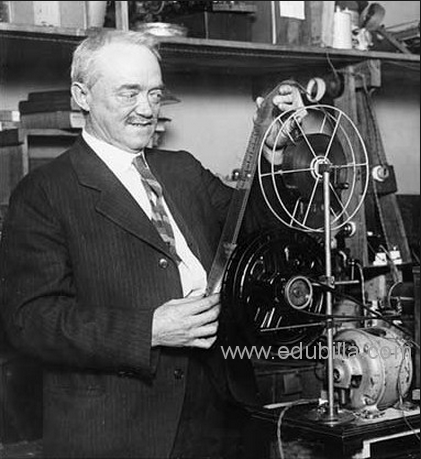










Charles Francis Jenkins (1867 – 1934) was an American pioneer of early cinema and one of the inventors of television, though he used mechanical rather than electronic technologies. His businesses included Charles Jenkins Laboratories and Jenkins Television Corporation (the corporation being founded in 1928, the year the Laboratories were granted the first commercial television license in the United States). Over 400 patents were issued to Jenkins, many for his inventions related to motion pictures and television .
In his free time, Jenkins fancied himself to be an inventor. Beginning in 1891, he tried to develop a motion picture projector. By 1892, he had succeeded in developing a machine that could project small moving pictures on a wall or screen, but the pictures were too small to be viewed by a large audience. In 1895, Jenkins left his stenographer position and entered into a business relationship with Thomas Armat. Together, the two men improved Jenkins's early invention. The two inventors unveiled their projector at the Cotton States Exposition in Atlanta, Georgia, in September 1895. Armat and Jenkins charged people twenty-five cents to view moving pictures, which were projected from the phantascope, Jenkins's and Armat's projector. Many historians give credit to Jenkins and Armat for also developing the movie theater to show their films at the Cotton States Exposition. The two men projected their films into two small rooms simultaneously from a single projection booth.
Jenkins's and Armat's relationship quickly deteriorated. In October 1895, Jenkins took one of the three phantascopes that the two men had manufactured to Richmond, Indiana, his boyhood home, to show residents his moving pictures. He also filed a patent for the phantascope, claiming that he was the sole inventor, although an earlier patent claimed that Jenkins and Armat were joint presenters. In the end, the U.S. Patent Office granted Jenkins and Armat the patent, rejecting Jenkins's claim that he was solely responsible for the phantascope. Angered with the Patent Office's decision, Jenkins continued to boast that he had developed the phantascope in 1894 and projected images for audiences in Richmond, Indiana, as early as June 6, 1894, a blatantly false statement. Jenkins also entered into an agreement with the Columbia Phonograph Company to manufacture the phantascope. In the meantime, Armat began negotiations to sell the phantascope patent to Thomas Alva Edison. Eventually Jenkins sold his rights to the phantascope to Armat, who sold his rights to Edison, causing many people to credit Edison with the invention of the motion picture projector, when it reality it was Jenkins and Armat. Following the dispute with Armat, Jenkins remained involved in the motion picture industry, helping found and serving as the first president of the Society of Motion Picture Engineers in 1916.
Perhaps Jenkins's next great contribution was in the field of television. Many scholars credit Jenkins with inventing the first television set in the United States. British inventor John Logie Baird broadcast images on a television in Europe a few months before Jenkins managed to complete the same task in the United States.
Jenkins utilized what became known as mechanical television or radiovision. He used radio receivers that had a special attachment, which allowed the receivers to broadcast moving pictures on a six-inch square mirror. Jenkins made the first public display of his radiovision on June 23, 1925, although he claimed that he transmitted the first moving pictures via radiovision on June 24, 1923. Most scholars believe that Jenkins's earlier broadcast was a lie on Jenkins's part.
On July 2, 1928, Jenkins formed the first television station in the United States and began broadcasting this same day. The station was known as W3XK and was located in Wheaton, Maryland. Jenkins's first program consisted of a ten-minute segment of a revolving windmill. In December 1928, Jenkins formed the Jenkins Television Corporation in New Jersey to manufacture Radiovisors, Jenkins's radiovision receivers, and to market and form television stations across the United States. In 1932, De Forest Radio purchased Jenkins Television Corporation and, a few months later, sold the Jenkins component of the company to RCA, which immediately ended production of the Radiovisors and ceased transmitting programs to mechanical televisions.
The principal reasons for RCA's decision to cease broadcasting and to end production were the expensive cost of Radiovisors -- the sets routinely cost between eighty-five and 135 dollars per set -- and the poor picture quality of mechanical televisions. The pictures commonly were too dark for viewers to see any more than silhouettes. These silhouettes became known as shadowgraphs. Also, by the early 1930s, dramatic improvements had been made in broadcasting images through what was known as electronic scanning television systems. Jenkins continued to seek ways to improve the Radiovisor until his death on June 6, 1934.
Over the course of his life, Jenkins received more than four hundred patents. Many of these patents were in the fields of motion pictures and television, but Jenkins also made numerous other contributions to society with his inventions. In 1898, Jenkins invented the first automobile with the engine in the front of the car instead of under the seat. In 1901, he designed an early sight-seeing bus and a decade later developed an early automobile self-starter. In addition to these and hundreds of other inventions, Jenkins also developed an airplane brake, a bean-shelling machine, and a conical paper drinking cup.
Elliott Cresson Medal (1897)
John Scott Medal (1913)

